“Ha! Bovine bounty hunters! Now I’ve seen everything.”
Sometimes, you’re sitting on a couch, aimlessly scratching the chin of an overly friendly cat, and then some animated bulls start sexually harassing an animated cow voiced by Judi Dench, and a cattle rustler voiced by Randy Quaid starts yodeling, turning the animated cows pink, and you start wondering where you went wrong in life.
And that’s all before Randy Quaid’s yodeling breaks into the William Tell Overture.
In the early 1990s, the Disney animation department was riding a new and unusual wave of excitement and cash, flush from the successes of The Little Mermaid and Beauty and the Beast. It was time, executives and animators alike agreed, for some new ideas, and artist and director Mike Gabriel, fresh from The Rescuers Down Under, where he had supervised the development of Disney’s new CAPS animation system, had one: a supernatural Wild West film.
Ghosts were mostly new to the animation studio, but Mickey’s Christmas Carol had done decently back in the day. Wild West shorts were not new to the studio, which had created several back in the 1940s and 1950s. None had exactly been a huge hit, but they continued to attract viewers when rebroadcast. It was enough for executives to agree to let Mike Gabriel start creating concept art for the new film, Sweating Bullets – once he’d finished work on the prestige feature Pocahontas.
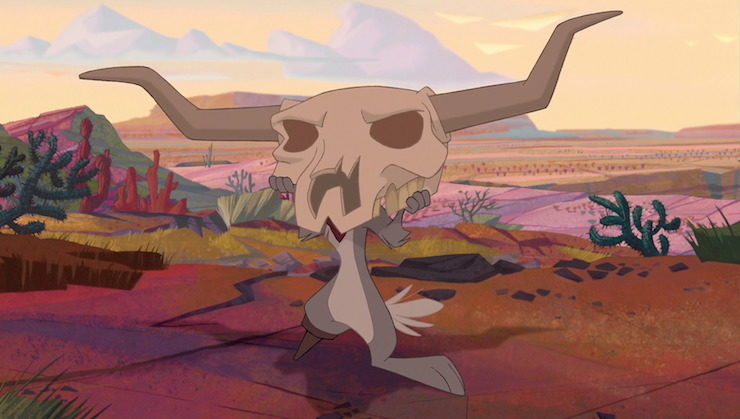
Unfortunately for Mike Gabriel, developing the story proved difficult, and the somewhat disappointing box office take for the much anticipated Pocahontas did not help his cause. In 2000, after making multiple changes to the story—including making the protagonist a bull named Bullets—he left the film. The project was handed over to Will Finn, now back with Disney after briefly following Jeffrey Katzenberg over to Dreamworks, where, among other things, he directed the successful The Road to El Dorado. Finn, who had worked with Disney throughout the 1980s and 1990s, knew most of the animators and Disney studio processes relatively well, and thought he could streamline this film into quick production. Executives also tapped John Sanford to help with the script and directing. It was the start of adding numerous storyboard artists and, eventually, six writers for the script, which probably contributed to the plot issues.
By that point, as mentioned in previous posts, Disney executives had a different problem on their hands: what type of animation to use. The Disney animated features had continued to do decently at the box office, but not to the levels of The Lion King. Worse, in recent years, they had been soundly defeated at the box office by films from a little company called Pixar—and Jeffrey Katzenberg, who had supervised the early days of the Disney Renaissance, was rapidly building up Dreamworks into another major rival. Both companies, Disney executives noted, were having tremendous success with something still relatively new: computer animation.
Despite their own reliance on computer animation for inking, coloring and special effects, and use of programs such as Deep Canvas to give the illusion of moving through a painting, Disney was not—quite—ready to completely give up the hand animated animation that had built the company in the first place, and more recently given it critical recognition throughout the Disney Renaissance. At the same time, it was difficult to ignore the financial success of Dreamworks and Pixar.
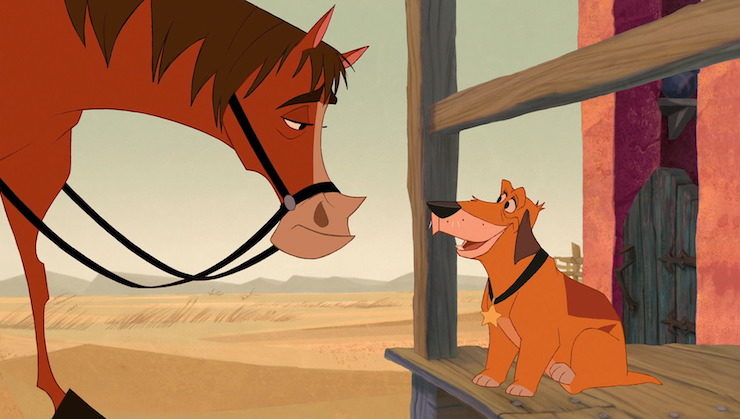
As Finn and Sanford reworked Sweating Bullets yet again, this knowledge hung over the studio. Still, Finn and Sanford decided to stick with hand drawn animation, and reworked the film yet again, splitting the main character, Bullet, into two characters, a bull called Junior and a horse called Buck. As they did, new disaster struck in the form of Treasure Planet, a financial disaster that led Disney executives to the decision to stop making hand animated films, and instead work with computer animation. The two films currently in production—including the Western film, now called Home on the Range—would be allowed to be completed, but after that, the studio would switch to computer animation.
Perhaps not surprisingly, this did not make the already slowed production on Home on the Range go any faster. Production, indeed, was so slow that Disney ended up shifting release dates, moving Brother Bear, a product of their Florida studio, into Home on the Range’s planned release spot. Animators still dawdled, until given an absolute last minute yes this will be released in April 2004 date we don’t care if you’re ready or not.
The delay stemmed from two separate, seemingly unavoidable issues: hand animating characters took time, and, given ongoing issues with the initial script, the main story had been changed yet again. The bull and the horse stayed around as largely minor characters, but the new story, directors decided, would focus on three cows and a yodeling cattle rancher. And since Disney did have money to spend on celebrity voice actors, somewhere along the line, someone got the bright idea of hiring both comedienne Roseanne Barr and Dame Judi Dench to voice two of the three cows.
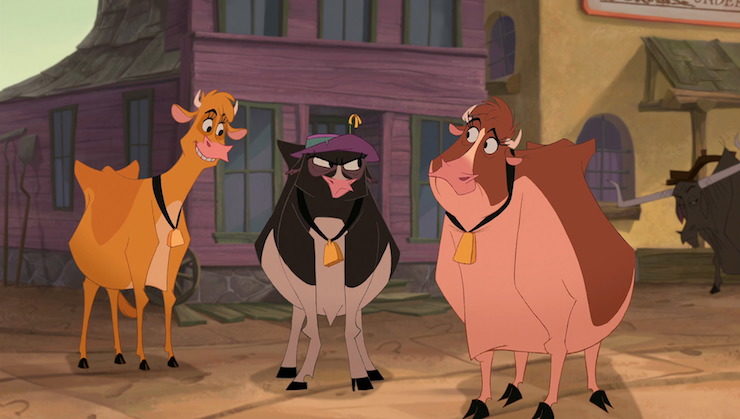
I should probably disclose at this point that I am not one of Roseanne Barr’s fans. To be fair, however, she’s hardly the worst part of the film, even if at all times she is clearly Roseanne Barr as a cow, only slightly toned down from her usual comic personality, right down to the mild vulgarity and occasional tasteless joke. Indeed, this film was immediately slammed with a PG rating and had to argue down a PG-13 rating, thanks to her opening joke about udders and a few later moments, though most of that and a later scene in a western saloon will go right over the heads of small viewers. And pairing her against Dame Judi Dench was almost an act of brilliance—with the “almost” more to do with the script than with either of the actresses. To play against them, Disney hired Jennifer Tilly to voice the third cow, filling out the rest of the cast with various celebrity voices and vocal talent including Cuba Gooding Jr., Steve Buscemi, and Randy Quaid as a yodeler.
And in a change from Disney’s usual habit of hiring one Top 40 performer for the nearly obligatory power ballad, Disney splurged on three Top 40 performers, hiring k.d. lang, Bonnie Raitt and Tim McGraw to perform three separate songs from a country-music/Western soundtrack written by Alan Menken, hired for a long term Disney contract after his success with several previous Disney films, with lyrics from Glenn Slater. If nothing here was quite as memorable as Menken’s earlier work for The Little Mermaid, Beauty and the Beast, and Aladdin, several of the songs at quite lovely. “Will the Sun Ever Shine Again,” sung by Bonnie Raitt, and reportedly written by Menken shortly after 9-11, is probably the musical highlight here.
Unfortunately, the music was one of the few highlights of the film, which otherwise, was mostly a mess. Quite possibly because of the endlessly changing storylines, directors, and release dates, or the overall pall lingering over the studio, Home on the Range struggles with dropped plot lines, confused character motivations, and some scenes that feel suspiciously like last minute additions meant to explain various things, which end up not really explaining any of those various things.
Take, for instance, the many issues with Roseanne Barr’s Maggie the cow. It’s not, as I noted, Roseanne Barr, but rather, Maggie’s confused and constantly ongoing shifting character motivations, which switch from altruistic to vengeful and back—when, that is, they aren’t completely forgotten.
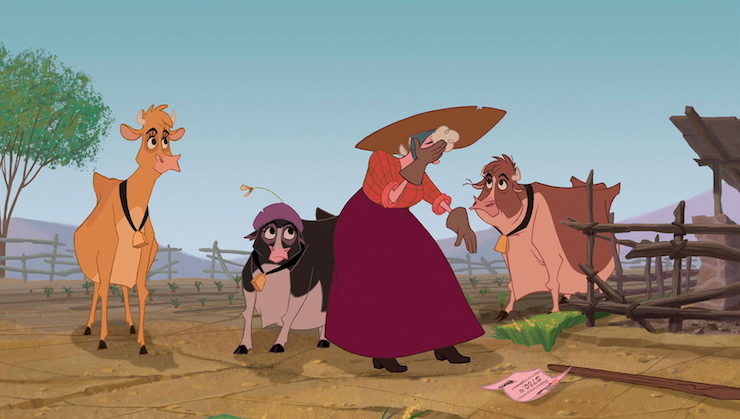
Her initial goal is clear: having already lost one home, she wants to save her new home, Patch of Heaven, currently threatened by bankruptcy if its owner, or her animals, can’t come up with $750 on the spot. Maggie comes up with a practical method of doing this: she and the other cows head off to a county fair to win money, something Maggie, a former prize cow, knows she can do. On the way, the cows find out that the sheriff just happens to have put out a $750 bounty—the exact amount the farm needs—on cattle rustler Alameda Slim, who just happens to be the very same cattle rustler that yodeled most of the herd away from Maggie’s former ranch, leaving her homeless. Maggie suggests going after Alameda Slim to get the bounty, which can save the farm.
A few scenes later, and Judi Dench—that is, Mrs. Calloway the cow—is claiming that Maggie’s intent from the beginning was vengeance, not saving the farm, and accuses Maggie of manipulating the other cows, even though, as viewers just saw, Maggie didn’t know that Alameda Slim was still around. Nor did Maggie even think of going after the cattle rustler until well after the cows had left their farm.
And yet, Maggie confesses that yes, vengeance has been her motive since the beginning, even though that can’t possibly be true.
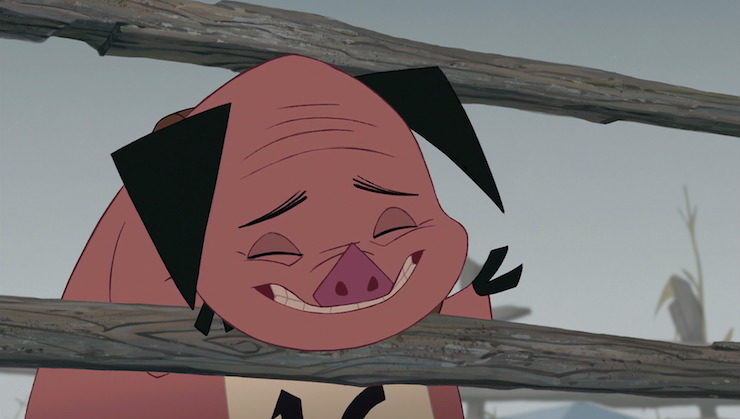
I can only assume that in an earlier script, Maggie was aware that Alameda Slim was still around, was seeking vengeance for her old ranch, and did manipulate the other two cows into helping her get her revenge—that is, until someone realized that a vengeful, manipulative cow was perhaps not the most sympathetic of characters. As a result, the entire plot of Maggie’s former ranch gets severely muddled, with several plot holes. For instance, how did Maggie—later shown to be fully susceptible to Alameda Slim’s yodeling, not get rustled away with the rest of the cows on her ranch in the first place? Why doesn’t Maggie recognize any of the cows hidden in the mine shafts by Alameda Slim and his incompetent goons, given that these are apparently cows from her own farm? Why don’t they recognize her?
And these are just the problems with Maggie. Other issues include dropped characters, the inexplicable decision to make Lucky Jack the Jackrabbit, among other things, a Native American shaman, the bulls who decide to sexually harass the cows—ok, yes, they are explicitly bulls, but still—the way the film suddenly introduces characters, then drops then, then several scenes later suddenly remembers that oh yes, the audience should be reminded about these characters, right (this is true both for Lucky Jack and for a number of the farm animals), several scenes that do nothing in particular, and oh yes, the yodeling.
To be fair, the yodeling is actually a plot point: it’s how Alameda Slim rustles cattle. His yodeling mesmerizes all nearby cows with perfect pitch—that is, all of the cows in the film except Maggie—turning him into a Pied Yodeller of sorts. It’s also just awful, especially when Randy Quaid—that is, Alameda Slim—starts yodeling various pieces of classical music, starting off a weird animation bit complete with dancing, eyes glazed over cows. The entire sequence is meant, I think, both to be a centerpiece of the film, and a throwback to Disney’s glory days, and in particular the pink elephant sequence in Dumbo. But love or hate Dumbo, at least no one in it tried to yodel any parts of Beethoven’s Ode to Joy.
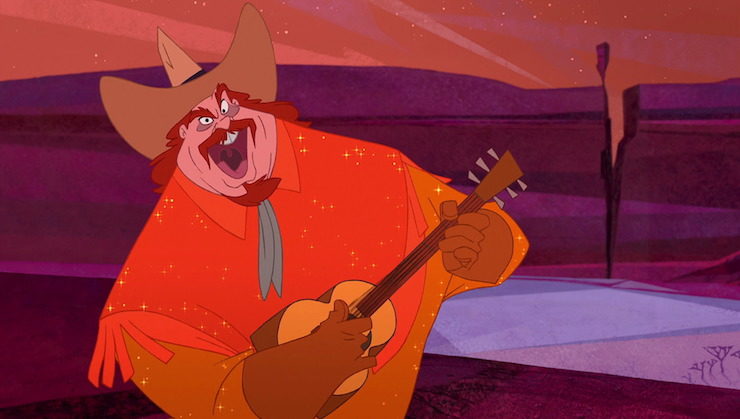
Randy Quaid, alas, does.
It’s topped by a later moment when crooked cattle dealer Wesley, voiced by Steve Buscemi, watches Alameda Slim and a rabbit roll down an old abandoned mine track, chased by a horse, chased by a buffalo, chased by some cows, chased by some goons yelling “UNCLE SLIM, UNCLE SLIM!” as Wagner’s Die Walkürie plays in the background, and Wesley says, “I gave up Clown College for this?” and I don’t think I have ever identified with Steve Buscemi as much before or since.
It’s Home on the Range in a nutshell: a film that often tries too hard to be funny, suddenly stops dead in the middle of the actual plot when it remembers that oh, yes, it does have other characters and should perhaps spend time on them, drops other plotlines, and has so many moments which ought to be great, but aren’t.
And oddly enough, although presented as a completely happy ending, the final moments are not exactly all that happy and satisfying, or for that matter, complete. Because, sure, the cows have managed to save Patch of Heaven, but apparently everyone, including Maggie, has forgotten the other farm—the Dixon Ranch, robbed at the beginning of the film, and still robbed and cowless at the end of the film. Sure, Maggie has her revenge and a new home—but what about all of the other cows and steers from that farm, not to mention poor Mr. Dixon, who still doesn’t have a ranch at the end of the film?
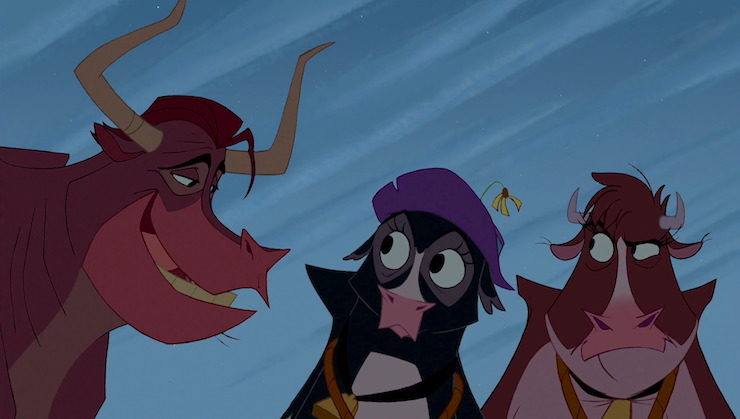
I also need to object to one minor note at the end: the bulls who earlier harassed Grace, Maggie, and Mrs. Calloway are not only completely forgiven for this, but end up dancing with the cows—joined by Junior the Buffalo, who had earlier chased them through an abandoned mine and nearly gotten them killed. I recognize that Disney likes to end its films with scenes showing everyone happily hanging out together, but in this case, it does seem a bit much, especially given Mrs. Calloway’s earlier clear disinterest in the bulls.
I need, however, to give Home on the Range credit for something still rare in full length Disney animated films: the decision to showcase several friendships between women. Not just between the cows, either: the chickens and geese have established firm friendships, and the women at the saloon don’t hesitate to unite to throw out some cows. (And one of those saloon women appears to be a cross-dresser, so kudos for that as well.) More than that, this is a film about three heroic women, who are trying to save their entire family from getting sold for food. The last time three heroic women stood up to defend themselves like this in a Disney animated film was back in Sleeping Beauty, and if I have issues with this film, I have to applaud it for at least this.
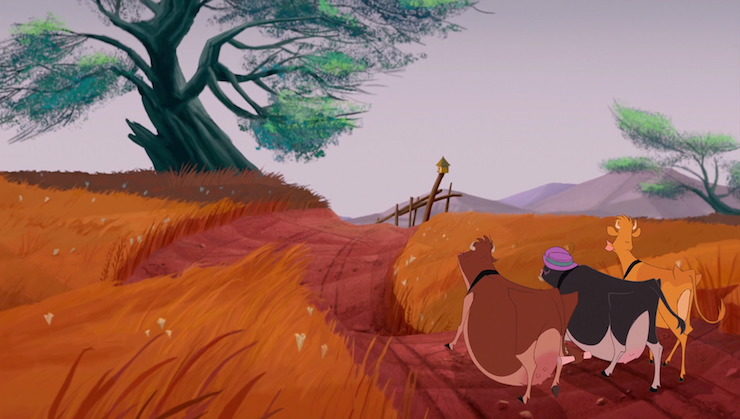
Audiences and critics did not applaud. The film was released in April 2004, the first time Disney had released a full length animated feature outside of their usual target seasons of summer or Christmas for decades. Years later, a similar release date would produce the blockbuster Zootopia, but no such fortune greeted Home on the Range. Whether it was the release date, or the rumors of vulgar humor, or something else is unclear, but after nearly fifteen years of work, Home on the Range did not even earn back its budget, bringing in only $103.9 million at the box office. Just twelve years later, Home on the Range DVDs were selling for just $5, well under the typical going rate for Disney films, and virtually all merchandise related to the film had vanished.
It was the final straw for Disney’s fabled yet beleaguered hand animation department. The studio would release only two more full length hand animated films, the 2009 The Princess and the Frog and the 2011 Winnie the Pooh. Instead, they focused on computer animated films.
Which brings us to Bolt, coming up next.
Mari Ness lives in central Florida.










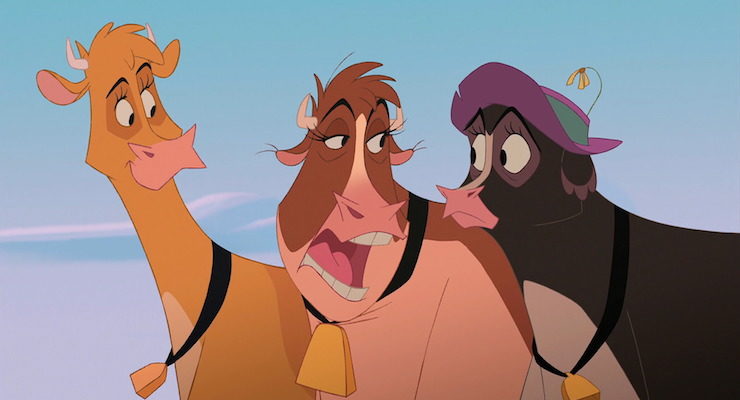
Oddly enough, this review makes me want to go see the movie after all. It doesn’t sound good, by any means. But…three cows on a quest to save a farm, while cracking jokes, with bouts of absurd slapstick and bizarre classical music mesmerizing yodeling cattle rustlers? Yeah, sure. That sounds interesting/weird enough that I need to see it at least once.
I remember this movie as being the only time I ever fell asleep in a movie theater. My 10 year old neice also fell asleep. It was THAT BAD.
I’m with fadeaccompli. This overwhelmingly negative review makes me want to see the movie, with alcohol on hand (Disney Drinking Game optional) and an ice pack ready for my friend who dope-slaps her forehead during bad/corny movies.
Sorry, but I’m laughing, imagining Mari Ness grabbing her skull in agony by the yodeling. “ACK ACK ACK!!!”
Are the laws protecting satire robust enough for MST3K to do this film?
I love the film and saw it multiple times in theaters. Like Cars, I think this movie plays much better to Midwesterners than to the New York/LA crowd.
Never seen the film, but I saw the previews, and mostly remember this:
Goat: They’re gonna eat us!
Hen, complacently: Who would eat a chicken?
*chicks look up with big innocent eyes*
A man yodeling classical music sounds like something straight out of a “Lives of the Cowboys” sketch on Prairie Home Companion.
I remember seeing this in theaters (Yes, in theaters. The word hadn’t gotten to us yet). I actually remember walking out of the theater with it having not whelmed me at all one way or the other, and my mom absolutely hating it. Which is hilarious, because I can look back on it now and realize that, yes, it was such a bad movie that holding your nose while walking out is an entirely appropriate action, and yet, it is not nearly bad ENOUGH to justify walking out halfway through (though the nadir of the film is easily the classical yodeling. If you don’t walk out then, you’re in it for the long haul).
How strange — if you’d asked me before I read this article, I would have said that this movie was computer animated. I never saw it; that impression was based solely on memories of theater posters. Unless there was some other cow-based animated movie released around the same time?
I’m with @1. I’ve never seen this movie, but the review has given me a morbid curiosity. I feel I must know what yodeling classical music sounds like because I can’t even begin to imagine.
@@@@@ Brian: You might possibly be thinking of Barnyard, which came out two years earlier. I know *I* confused the two; when Home on the Range was mentioned last week, I thought “Oh no, not the one that had male cows with udders!” and I’m not the only one to make that mistake (as seen in the comments on last week’s article). I haven’t seen either movie, but the notoriety that Barnyard gained for that element may have caused it to eclipse the other movie in people’s minds.
@@@@@ Matthew: I think that may have been it, yeah. Sorry to dredge up a discussion that was covered in last week’s comments. Also sorry that I went looking for images of posters from Barnyard, to confirm your supposition. I suggest forgetting that either movie ever happened, and moving on to Bolt, which is a much more enjoyable movie.
I know we already skipped them in the timeline, but I’m curious what happened to the pair of Goofy movies? Did I miss a memo about them getting skipped?
I still get “Will the Sun Ever Shine Again?” stuck in my head now and then.
The reason Maggie didn’t get rustled along with the rest of the herd at her former home is because she was a show cow, and was locked in the barn when the rest were taken. Judi Dench’s character is quite scandalized to find that their new resident is “a show cow”!
Jennifer Tilly’s character is the cow who is immune to the yodeling, because she is tone deaf. Once they figure this out, the others shove stuff in their ears to block the sound, I think. She also ends up with the macho bison at the end!
AlcairNovall – We skipped A Goofy Movie, DuckTales the Movie: Treasure of the Lost Lamp, Piglet’s Big Movie, Pooh’s Heffalump Movie and a couple of Tinker Bell films because they are products of the DisneyToon Studios, not the main Disney Animation department, and not listed by Disney on the list of official Walt Disney Animation Studios feature films.
I did leave three questionable films in the rewatch either because they were connected to Walt Disney Animation Studios or turned out to be important films for the history of the studio. This included Victory Through Air Power, which Disney does not list (or consider) a Walt Disney Animation Studios film, but which was produced by the Disney animation studios in between listening to military test flights; Dinosaur, which was not produced by the main Disney studios, but which Disney currently lists as a Walt Disney Animation Studios film, and Who Framed Roger Rabbit, which featured cameos from classic Disney films and helped launch the Disney Renaissance.
I remember this film as being a hot mess, and wondering how something this disjointed could have ever made it through any sort of review or quality control process.
Because I’m a completist (and misery loves company) I found a copy of this DVD to watch.
I actually didn’t think it was that bad. I’d watch it over any of the anthology pieces for sure (not counting Fantasia/Fantasia 2000 in that)…I would DEFINITELY watch it over Chicken Little (a movie I found vastly more annoying, nonsensical and unattractive in terms of animation)…in fact, I’d probably watch it over some of the more lackluster offerings from the 60s/70s. No, it’s no Zootopia or Wreck-It Ralph or Little Mermaid or Sleeping Beauty – definitely middle of the pack in terms of movies, but I’m not sure where all the hate comes from (although I also liked Treasure Planet, which is their biggest bomb to date) – I’ve heard it consistently described as one of Disney’s worst movies. I might even like this one better than Princess and the Frog, but that’s more becuase of various personal annoyances I had with that movie.
I had thought that the animation I remembered from promotions/trailers was ugly – maybe I just remember the pointiness of the cows – but I was pleasantly surprised at how much I liked the colorful landscapes and the general color pallette.
As for the plot – yup, pretty standard/straightforward/cliche but nothing that was horribly awful. Actually, the idea of a yodeling cow rustling villain is kind of absurd enough to be funny to me. And the yodeling wasn’t that bad or even that apparent – he gets one main song and a few scenes during the main climax where he yodeled. I guess it didn’t bother me that much.
Roseanne was fine – better than I expected actually. But while I am not a particular fan of hers, I did grow up watching Roseanne (and my general socieconomic position growing up was about what that show portrayed) so maybe I had a few more positive associations surrounding her.
For me the most annoying parts were the three stupid henchmen (the voice drove me nuts) and the overeager bulls, although I appreciated that the cows were able to handle them without trouble. I feel like that kind of ‘overly eager/desparate men portrayed as flirting’ humor was kind of big in the 90s even if it doesn’t play nearly so well now and just evokes stalking and harassment. I did lift an eyebrow at the end, where they show up and they all dance happily together but that’s a pretty typical Dance Party Ending, I guess. But yeah, I get it, the whole message that you can be really annoying and pushy and eventually get an in is annoying. Although I recall, Mrs. Calloway was dancing with the buffalo, NOT the bulls she clearly didn’t like earlier. She actually did seem slightly more receptive to the buffalo’s attentions ;)
I felt the same way about the movie at least being about 3 female cows on and aventure and doing pretty well for themselves, really.
As for the plot, I agree that the jackrabbit Shaman (really?) was a bit much but other than that I didn’t have too many issues with it. But regarding a few of the other concerns:
1)I thought that the bulls in the end scene were from a totally different cattle raid (the one that they witness after they leave) and that he had already sold the ones from Dixon’s farm.
2)Maggie wasn’t stolen becuase she was penned in; she had her own barn.
3)I didn’t take Maggie’s motivations as inconsistent per se – I think originally she was motivated by saving her new home, but once she realized Alameda Slim was still at large, her motivations shifted to the point where she may have been more focused on that. At any rate, people are full of multiple (and sometimes contradictory) motivations so that doesn’t really bother me.
4)Yes, the happy ending is generally only for Patch of Heaven, but perhaps given that they’ve caught Alameda (does Rico just get off?) they may be able to make restitution and give the land back, although the cows are pretty much gone…
Aside: I was amused that the cow buyer actually WAS Steve Buscemi, as I was pretty convinced for most of Zootopia that Weaselton was Steve Buscemi only to find it was Alan Tudyk. I knew Alan Tudyk wasn’t doing voicework during this time period, so I wondered who they had gotten to imitated him this time ;)
Anyway – this is probably way more than this movie really warrants, heh.
Am I the only person who actually really liked this movie? My family loves it. My mom loves it. My siblings love it. I don’t see the plot holes you’re referring to. Maggie wasn’t taken by Slim the first time because she was locked in the barn and couldn’t get out. The cows originally at the Dixon ranch were sold to Wesley before Maggie, Grace, and Calloway even got there. So no, Maggie wouldnt habe recognized them or vice versa. The cows they ran into when they got to Slim’s hideout was the same group of cows that were kidnapped during Slim’s yodeling song. Jack had plenty of screen time, as did the other animals. The movie wasn’t even about them anyway. It’s not the first Disney movie (and certainly not the last) that has “ignored” minor characters who had nothing to do with the main plot. The music is fantastic. And as for the adult jokes….are you serious? How many Disney movies can you name that have had adult jokes in it? Aladdin. The Lion King. Frozen. Just to name some of the bigger ones. Don’t single out Home on the Range due to a few bits of adult humor. It may not be one of the most popular movies, but it certainly isn’t one of their worst. Same with Treasure Planet. I love this movie. It’s a great addition to the Disney Canon.
I just saw this movie and hated it. I’m a Southerner and where they got it wrong was in casting Roseanne Barr to play a cow in the south. There’s nothing worse than hearing someone try to fake a southern accent, which happens with some of the other characters in this movie as well. The film felt rushed. It was all over the place and nothing really stood out or became memorable. Just so much wrong with this film.